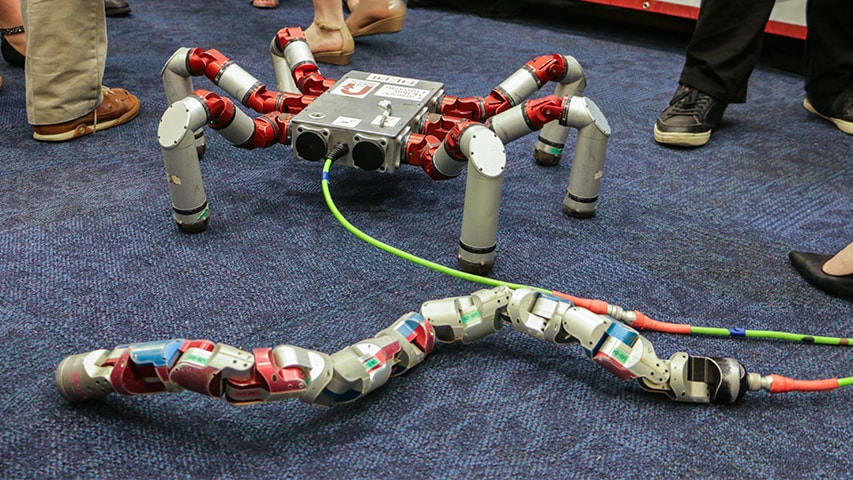CMU Showcases Work at National Robotics Initiative Event in D.C.
By Abby Simmons / 412-268-4290 / abbysimmons@cmu.edu
Photo courtesy of the National Science Foundation
Carnegie Mellon University researchers are developing robots to enhance minimally invasive surgery, advance prosthetics, aid in mine rescue, improve bridge inspections, assist the blind and even traverse the moon — work that has collectively received 17 awards from the National Robotics Initiative.
Congressional Robotics Caucus co-chairs Congressmen Mike Doyle (D-PA) and Rob Woodall (R-GA) on June 9 hosted an event in Washington, D.C., to celebrate the NRI’s fifth anniversary, featuring researchers from CMU and around the country.
“Five years after the establishment of the National Robotics Initiative, I’m proud of the progress we’ve made in developing robotics technology that will benefit American consumers, businesses and governments,” Doyle said. “Over the last five years — and for decades before that, in fact — Carnegie Mellon has consistently been in the forefront of the effort to develop and expand US leadership in the fields of computers, artificial intelligence, and robotics. As one of the founders and co-chairs of the House Robotics Caucus, I look forward to working with my House colleagues and innovators like CMU to make more advances in the years to come.”
“The National Robotics Initiative has provided funding for fundamental research that is essential for the development of the U.S. robotics industry and has created a collaborative community where researchers can share their expertise, algorithms, data and best practices,” said Martial Hebert, director of CMU’s Robotics Institute.
“Beyond extending robotics research into all areas of work and daily life, the NRI plays a central role in producing the next generation of researchers for this rapidly expanding field,” Hebert said.
Hebert moderated a panel discussion on the impact of the NRI among leaders from industry, academia and the federal government, while CMU researchers Howie Choset and Koushil Sreenath were among NRI funding recipients invited to demonstrate their robots.
Choset, a Robotics Institute professor, showed how his snake robots thread through tightly packed regions, accessing locations that people and conventional machinery cannot. They have been used in medical procedures, urban search and rescue missions, and building aircraft wings.
“I normally would not have been able to collaborate with Vanderbilt and Johns Hopkins universities on medical robotics if it had not been for the NRI. This work will lead to minimally invasive surgical techniques, which will ultimately cause less pain for the patient while at the same time making medical care more readily available,” Choset said.
Sreenath, an assistant professor with appointments in CMU’s College of Engineering and Robotics Institute, demonstrated a lower-limb robotic prosthesis along with Aaron Ames of Georgia Institute of Technology and Jessy Grizzle of the University of Michigan.
First announced by President Obama in 2011 as part of the Advanced Manufacturing Initiative, the NRI is designed to accelerate the development and use of robots that work beside or cooperatively with people. It is a multi-agency effort among the National Science Foundation, National Aeronautics and Space Administration, National Institutes for Health, U.S. Department of Agriculture, U.S. Department of Energy and U.S. Department of Defense.
NRI funding supports areas of national priority, including manufacturing, sustainable agriculture, space and undersea exploration, health, transportation, personal and homeland security, and disaster resiliency and sustainable infrastructure.